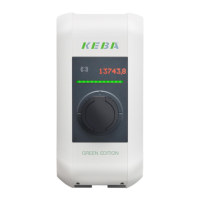
Do you have a question about the Keba KeContact KC-P30 x Series and is the answer not in the manual?
| Charging power | up to 22 kW |
|---|---|
| Rated current | 32 A |
| Connection type | Type 2 |
| Protection class | IP54 |
| Output Power | up to 22 kW |
| Output Current | 32 A |
| Cooling | Natural convection |
| Operating Temperature | -25°C to +55°C |
| Rated voltage | 400 V |
| Communication interfaces | Ethernet |
| Output Voltage | 400 V |
| Residual current monitoring | Integrated DC residual current protection (RCM DC 6mA) |
Explains safety symbols like DANGER, WARNING, CAUTION, ESD, and Information.
Describes the manual's scope: configuration of advanced P30 x-series features after installation.
Lists required knowledge and abilities for electricians, including safety and network basics.
Explains warranty conditions and states that unauthorized tampering voids the warranty.
States the manual is part of the product and must be followed for safety and correct operation.
Provides website link for additional manuals, installation guides, and FAQs.
Lists available network interfaces: LAN, WLAN, WLAN access point, and mobile communications.
Explains connecting via LAN to a router for internet/OCPP backend access and other charging stations.
Explains connecting via WLAN to a router for internet/OCPP backend access.
Describes using the device as a WLAN hotspot for mobile device access and configuration.
Explains connecting via mobile network to an OCPP backend using a SIM card.
Details setting up a local network with master/client stations, including direct connection and router/switch connection.
Explains the meaning of LED bar displays and status indicators on the charging station.
Details the direct LAN connection between a master and a single client station.
Details connecting multiple client stations via a router or switch to the master.
Lists required ports (TCP/UDP) for communication within the charging network and their purpose.
Describes accessing the connection panel for interfaces and controls for configuration.
Explains DIP switch settings required for master and client charging station communication.
Details enabling the DHCP server on the master for network configuration.
Explains saving and transferring configurations using a USB stick for multiple units.
Describes configuring a first unit via the web interface as a basis for others.
Explains transferring configuration from an operational unit to a USB stick.
Describes adapting the configuration file on the USB stick for different charging stations.
Explains loading the configuration from the USB stick into another charging station.
Explains accessing the web interface using the master's IP address for configuration.
Describes the status page showing overview information about charging stations in the network.
Details viewing and exporting charging session data from the last 12 months.
Explains managing RFID cards, including teaching-in, editing, deleting, and exporting/importing.
Covers configuration of the charging network, including preferences and operating modes.
Outlines system functions like software update, logging, and factory data reset.
Explains configuring device settings, network connection, routing, proxy, and OCPP.
Covers user-specific settings like username, password, language, and remote service access.
Explains load management in a local charging network, dividing power among stations.
Describes how charging current is divided evenly across active sessions when power is limited.
Explains balancing phases to avoid unstable networks and define max current for asymmetrical loads.
Details methods for regulating current limiting, including DIP switches, master assignment, UDP, and external meters.
Explains phase-related load management for 3-phase connections to regulate uniform current distribution.
Describes RFID authorization for starting charging sessions using ISO standards and RFID readers.
Details online and offline authorization modes for comparing RFID cards against local or backend storage.
Explains LED bar patterns and acoustic signals indicating authorization status and card read events.
Details managing RFID cards at the reader or via the web interface without an OCPP backend.
Details RFID authorization when controlled by an OCPP backend, requiring central teaching and web interface settings.
Outlines the steps to start a charging process using RFID authorization.
Explains connecting to a central management system via OCPP, supporting versions 1.5 and 1.6.
Describes transmitting information and receiving commands via UDP or Modbus TCP for smart home integration.
Explains reading measured values from external meters via Modbus TCP for intelligent charging and optimization.
Details connecting external meters via Ethernet1, ensuring same phase sequence and network.
Lists supported meter manufacturers and models for integration with the Janitza ProData 2 datalogger.
Explains configuring Modbus TCP for external meters and handling connection interruptions.
Directs users to website FAQs for rectifying possible errors and issues.
Recommends keeping the station updated for enhancements and bug fixes, with updates available on the website.
Details performing a software update through the charging station's web interface.
Explains how to perform a software update using a USB stick, including required preparation steps.
Describes performing software updates for the entire network via the OCPP backend using an FTP link.